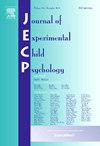Examining methodological influences on the rhythmic priming effect: A commentary on Kim, McLaren, and Lee (2024)
IF 1.8
2区 心理学
Q3 PSYCHOLOGY, DEVELOPMENTAL
引用次数: 0
Abstract
The rhythmic priming effect (RPE) refers to improved language performance (typically grammaticality judgements) following regular rhythmic primes compared to various control conditions. This effect has been observed primarily in French, but also in English and Hungarian. However, a recent implementation by Kim, McLaren & Lee (2024), aiming to replicate the RPE in English (Chern, Tillmann, Vaughan & Gordon, 2018), was not successful, inviting a discussion about the conditions under which the RPE could be observed. We here discuss features of Kim et al.’s (2024) implementation that might have reduced the probability of observing the RPE. Compared to Chern et al. (2018), and numerous other studies reporting the RPE, additional delays after the primes and before each sentence were introduced by Kim et al. (2024). This change might have limited beneficial prime effects, which persist, but decay over time. Further, their instruction to “relax and have some rest” might have reduced attentive processing of the primes and related entrainment. Finally, their sample was small (n =16 per experiment) and with a large age range for investigating typically developing children (7-12y), potentially reducing experimental effects due to development-related individual variations. These methodological changes and sample characteristics are discussed in relation to previous research on the RPE, and entrainment in general. This discussion prompts the need for future research to investigate conditions leading to the RPE, with the aim to shed light on underlying mechanisms. Better understanding the RPE will be critical for the use of rhythmic priming within clinical and educational settings.
研究方法对节奏引物效应的影响:对 Kim、McLaren 和 Lee(2024 年)的评论。
节奏引物效应(RPE)是指与各种对照条件相比,有规律的节奏引物会提高语言成绩(通常是语法判断)。这种效应主要是在法语中观察到的,但也在英语和匈牙利语中观察到。然而,Kim、McLaren 和 Lee(2024 年)最近实施的一项旨在在英语中复制 RPE 的研究(Chern、Tillmann、Vaughan 和 Gordon,2018 年)并不成功,从而引发了关于在何种条件下可以观察到 RPE 的讨论。我们在此讨论 Kim 等人(2024 年)实施方案的特点,这些特点可能会降低观察到 RPE 的概率。与 Chern 等人(2018 年)以及其他许多报告 RPE 的研究相比,Kim 等人(2024 年)在素材之后和每个句子之前引入了额外的延迟。这种变化可能限制了有益的原语效应,因为这种效应会持续存在,但随着时间的推移会逐渐减弱。此外,他们关于 "放松并休息一下 "的指示可能会减少对原语和相关诱导的专注处理。最后,他们的样本较小(每次实验的样本数为 16 人),而且调查的典型发育儿童的年龄范围较大(7-12 岁),这可能会减少因发育相关的个体差异而产生的实验效果。这些方法上的变化和样本特征将结合以往有关 RPE 和一般诱导的研究进行讨论。这些讨论表明,未来的研究需要对导致 RPE 的条件进行调查,目的是揭示其背后的机制。更好地了解 RPE 对在临床和教育环境中使用节奏引物至关重要。
本文章由计算机程序翻译,如有差异,请以英文原文为准。
求助全文
约1分钟内获得全文
求助全文
来源期刊

Journal of Experimental Child Psychology
Multiple-
CiteScore
4.50
自引率
7.70%
发文量
190
期刊介绍:
The Journal of Experimental Child Psychology is an excellent source of information concerning all aspects of the development of children. It includes empirical psychological research on cognitive, social/emotional, and physical development. In addition, the journal periodically publishes Special Topic issues.
 求助内容:
求助内容: 应助结果提醒方式:
应助结果提醒方式:


